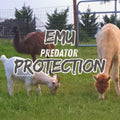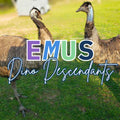
Eastern Equine Encephalitis Risk & Prevention in Emus
Eastern Equine Encephalitis (EEE) poses serious risks to both emus and humans. Learn about symptoms, transmission, high-risk regions, prevention, and vaccination strategies in this educational article.
There is also a Western Equine Encephalitis. However it is not nearly as dangerous and deadly as it's Eastern sister virus.
Subscribe
To join our mailing list and never miss an update!
Eastern Equine Encephalitis (EEE) is a rare but deadly mosquito-borne disease that affects both animals and humans. While it is most commonly associated with horses, emus are also highly susceptible to the virus. EEE is caused by an alphavirus transmitted through the bites of infected mosquitoes, and its effects can be devastating due to its high mortality rate and potential for severe neurological damage.
This article provides an educational and actionable look at EEE, including how it spreads, its symptoms, high-risk regions, and prevention strategies. Understanding the risks associated with EEE is critical for emu owners and individuals living in areas where the virus is prevalent.

HOW EEE SPREADS
EEE is primarily spread through the bite of an infected mosquito. The virus is maintained in a bird-mosquito cycle, where wild birds act as the primary reservoir. Certain wild bird species, particularly passerine birds (e.g., songbirds, sparrows, blackbirds, robins, and wading birds like herons and egrets), serve as amplifying hosts for EEE.
This means that when they are infected, they develop a high enough viral load in their blood (viremia) for mosquitoes to pick up the virus when feeding on them. These infected mosquitoes then transmit EEE to other birds, continuing the cycle. When these infected mosquitoes bite mammals such as horses or humans—or ratites like emus—they can transmit the virus.
For a long time it was believed that livestock, emus, and humans were considered "dead-end hosts", meaning they do not develop high enough viral levels in their blood to infect mosquitoes that may bite them and progress the cycle further. This means that once an animal or human contracts EEE, they are not contagious to others.
That understanding has changed. Researchers have since observed a few lab specimens carrying extremely high viral loads, indicating emus may play a more active role in transmission than previously thought.

HIGH-RISK REGIONS FOR EEE IN THE UNITED STATES
Eastern Equine Encephalitis (EEE) is primarily found in North, Central, and South America, with the United States being the most affected. EEE is most commonly found in regions with freshwater hardwood swamps, as these environments support mosquito populations that carry the virus. The highest-risk areas include:
• The Southeastern U.S. – Florida, Georgia, and the Carolinas
• The Northeastern U.S. – Massachusetts, Connecticut, Rhode Island, and New Jersey
• The Great Lakes Region – Michigan, Wisconsin, and Indiana
• The Gulf Coast – Louisiana, Mississippi, and Texas
The species of mosquitoes that carry EEE (such as Culiseta melanura) are primarily found in the Western Hemisphere, limiting the virus’s natural spread beyond the Americas. No confirmed cases of EEE have been reported outside the Americas, but related encephalitic viruses exist in other parts of the world, such as West Nile Virus (WNV) in Europe and Japanese Encephalitis (JE) in Asia.
EEE outbreaks tend to occur more frequently during late summer and early fall, coinciding with peak mosquito activity.

DANGER OF EEE TO EMUS
Emus are particularly susceptible to EEE, and the virus can cause sudden and severe symptoms. Unlike some other bird species that can carry the virus asymptomatically, emus frequently develop serious neurological issues and a high mortality rate when infected.
Symptoms of EEE in Emus:
• Loss of coordination
• Weakness and lethargy
• Seizures and tremors
• Paralysis
• Inability to stand
• Sudden death
Since there is no specific treatment for EEE, preventive measures such as vaccination and mosquito control are critical to protect emus from infection.
EEE Vaccine Recommendations for Emus
While there is no EEE vaccine specifically formulated for emus, many breeders and veterinarians use the equine EEE vaccine off-label with the following dosage guidelines:
• Vaccine Type: Inactivated equine EEE/WEE vaccine
• Dosage: 1 mL per emu, administered intramuscularly (IM)
• Initial Vaccination: Two doses, 2–4 weeks apart for unvaccinated emus
• Annual Booster: One dose before mosquito season
• High-Risk Areas: Some breeders administer a booster every six months
Young emus (3–4 months old) can be vaccinated, but it is recommended to consult an avian or exotic animal veterinarian to determine the best protocol for specific flocks.

DANGER OF EEE TO HUMANS
Though rare, EEE is one of the most severe mosquito-borne illnesses in the United States, with a 30-50% mortality rate in symptomatic cases. Even survivors often suffer permanent neurological damage, including cognitive impairment, paralysis, and seizures.
Symptoms of EEE in Humans
EEE symptoms usually appear 4-10 days after a mosquito bite. The severity varies, but the virus progresses rapidly in serious cases.
Early Symptoms (Mild Cases):
• Fever
• Chills
• Headache
• Muscle aches
• Fatigue
Severe Symptoms (Encephalitis Stage):
• High fever (103°F+)
• Stiff neck
• Severe headache
• Disorientation
• Seizures
• Vomiting
• Tremors
• Paralysis
• Coma
Individuals under 15 years old and over 50 years old are at the highest risk of severe illness. There is no cure or specific antiviral treatment for EEE, so supportive hospital care is the only option for affected patients.
EEE PREVENTION STRATEGIES
Because there is no treatment for EEE, prevention efforts should focus on mosquito control and vaccination for emus in high-risk areas.
1. Eliminate Standing Water: Mosquitoes breed in stagnant water, so remove puddles, birdbaths, clogged gutters, and other potential breeding sites.
2. Use Mosquito Repellents: DEET, picaridin, or oil of lemon eucalyptus can help protect humans from bites.
3. Wear Protective Clothing: Long sleeves, pants, and socks help reduce exposure.
4. Install Mosquito Netting & Screens: Protect enclosures and living areas.
5. Time Outdoor Activities Wisely: Avoid being outside at dawn and dusk when mosquitoes are most active.
6. Vaccination for Horses and Emus: Equine EEE vaccines are highly effective at preventing infections in horses and are commonly used off-label for emus. Annual vaccination before mosquito season is strongly recommended in endemic areas.
Trending Articles

WESTERN EQUINE ENCEPHALITIS
It’s worth noting that there is also a Western Equine Encephalitis. While Western Equine Encephalitis (WEE) and Eastern Equine Encephalitis (EEE) are both mosquito-borne viral diseases that affect horses, humans and some bird species, they differ in geographic distribution, severity, and transmission cycles.
EEE is far more severe and deadly in both humans and horses compared to WEE. Although WEE can still cause encephalitis, it is much less common, and most people recover without lasting effects.
Eastern Equine Encephalitis is a deadly and unpredictable disease that poses a serious threat to emus, horses, and humans alike. Due to its high fatality rate and the absence of a cure, prevention through vaccination and mosquito control is the best line of defense.
Emu owners should consult with veterinarians about appropriate vaccination protocols, while individuals in high-risk areas should take proactive steps to reduce mosquito exposure. By understanding EEE’s risks and transmission, we can take the necessary precautions to protect both animals and people from this devastating disease.
Trending Products
Copyright©2025 All rights reserved. We love to have you share our article as long as you include a direct link to this page. This article or any portion thereof , including all images, may not be reproduced or used in any manner whatsoever without the express written permission of Gypsy Shoals Farm.



